Marketing and Service Management: Gap Model and Customer Relationships
VerifiedAdded on 2022/09/10
|13
|4207
|18
Essay
AI Summary
This essay critically evaluates the gap model of service quality and its evolution, exploring its usefulness in understanding customer relationships within organizations. It begins with an introduction to marketing and service management, highlighting the significance of the gap model in assessing consumer satisfaction. The essay delves into the five gaps of the model: knowledge, policy, delivery, communication, and customer, providing detailed explanations and real-world examples, such as Netflix, to illustrate each gap. Furthermore, the essay examines the concept of customer relationships, emphasizing their role in enhancing customer experiences and fostering loyalty. It differentiates between customer service and customer relationships, discussing both proactive and reactive functions. The essay concludes by emphasizing the benefits of positive customer relationships, including customer retention and satisfaction. The essay provides an in-depth analysis of the topic.
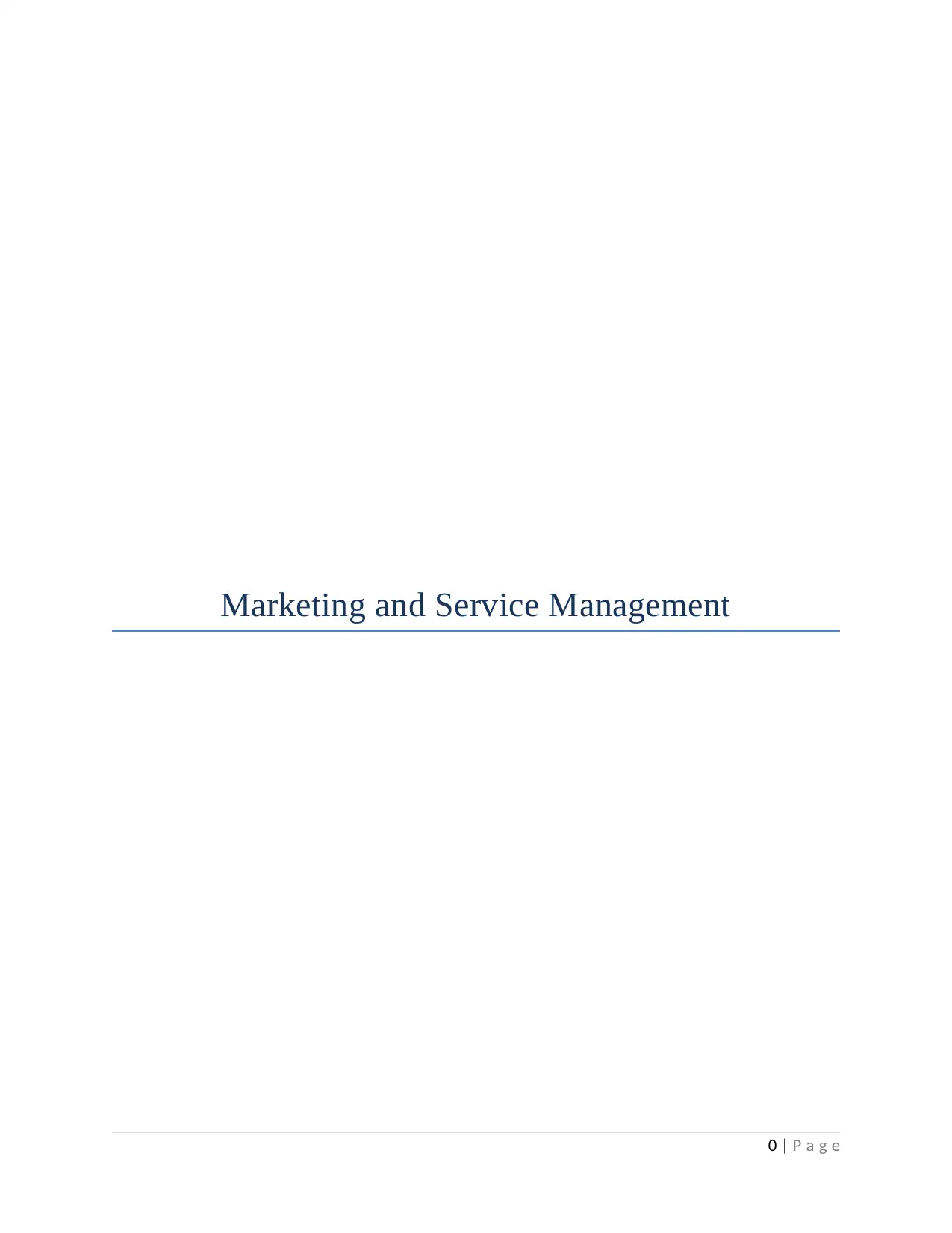
Marketing and Service Management
0 | P a g e
0 | P a g e
Paraphrase This Document
Need a fresh take? Get an instant paraphrase of this document with our AI Paraphraser
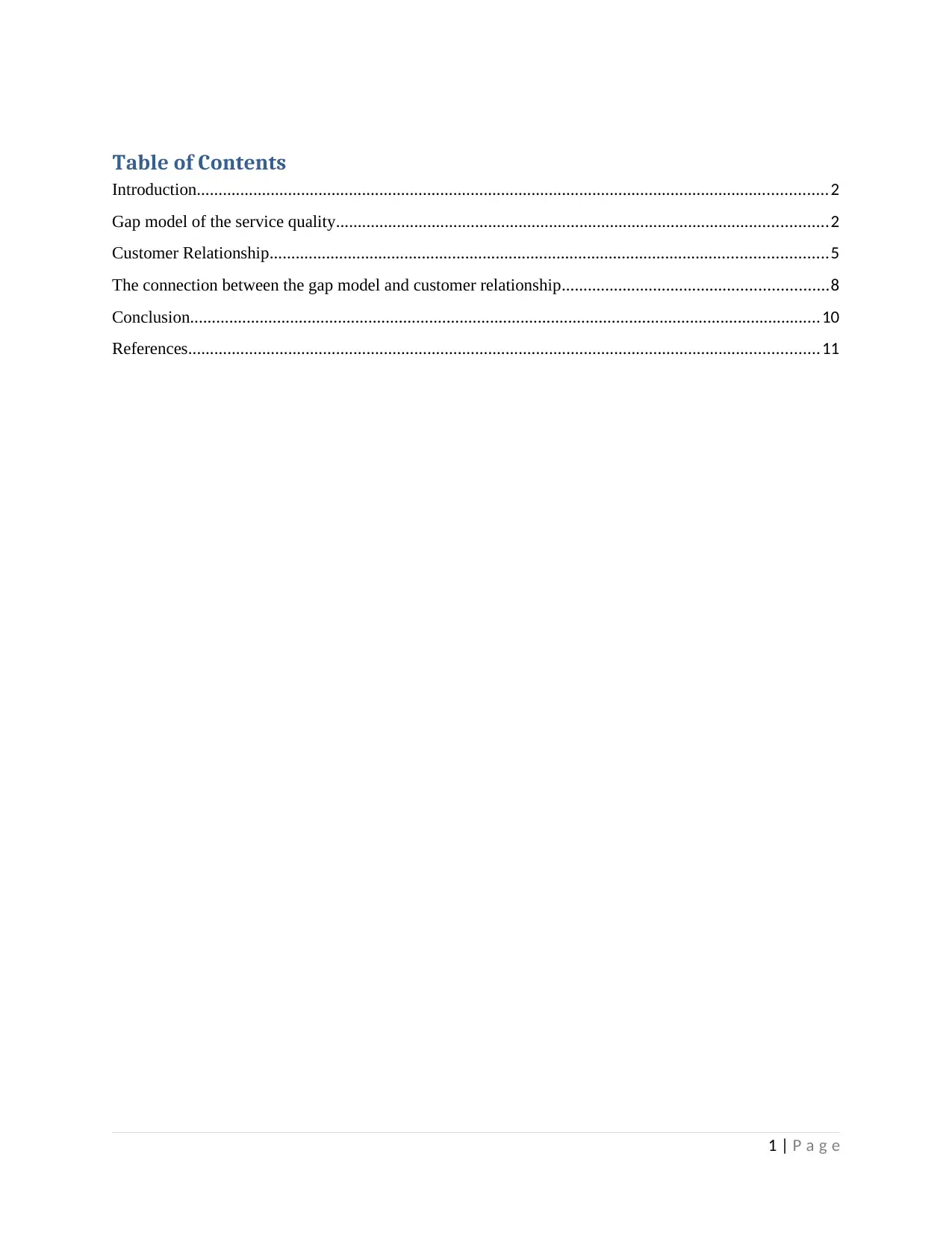
Table of Contents
Introduction.................................................................................................................................................2
Gap model of the service quality.................................................................................................................2
Customer Relationship................................................................................................................................5
The connection between the gap model and customer relationship.............................................................8
Conclusion.................................................................................................................................................10
References.................................................................................................................................................11
1 | P a g e
Introduction.................................................................................................................................................2
Gap model of the service quality.................................................................................................................2
Customer Relationship................................................................................................................................5
The connection between the gap model and customer relationship.............................................................8
Conclusion.................................................................................................................................................10
References.................................................................................................................................................11
1 | P a g e
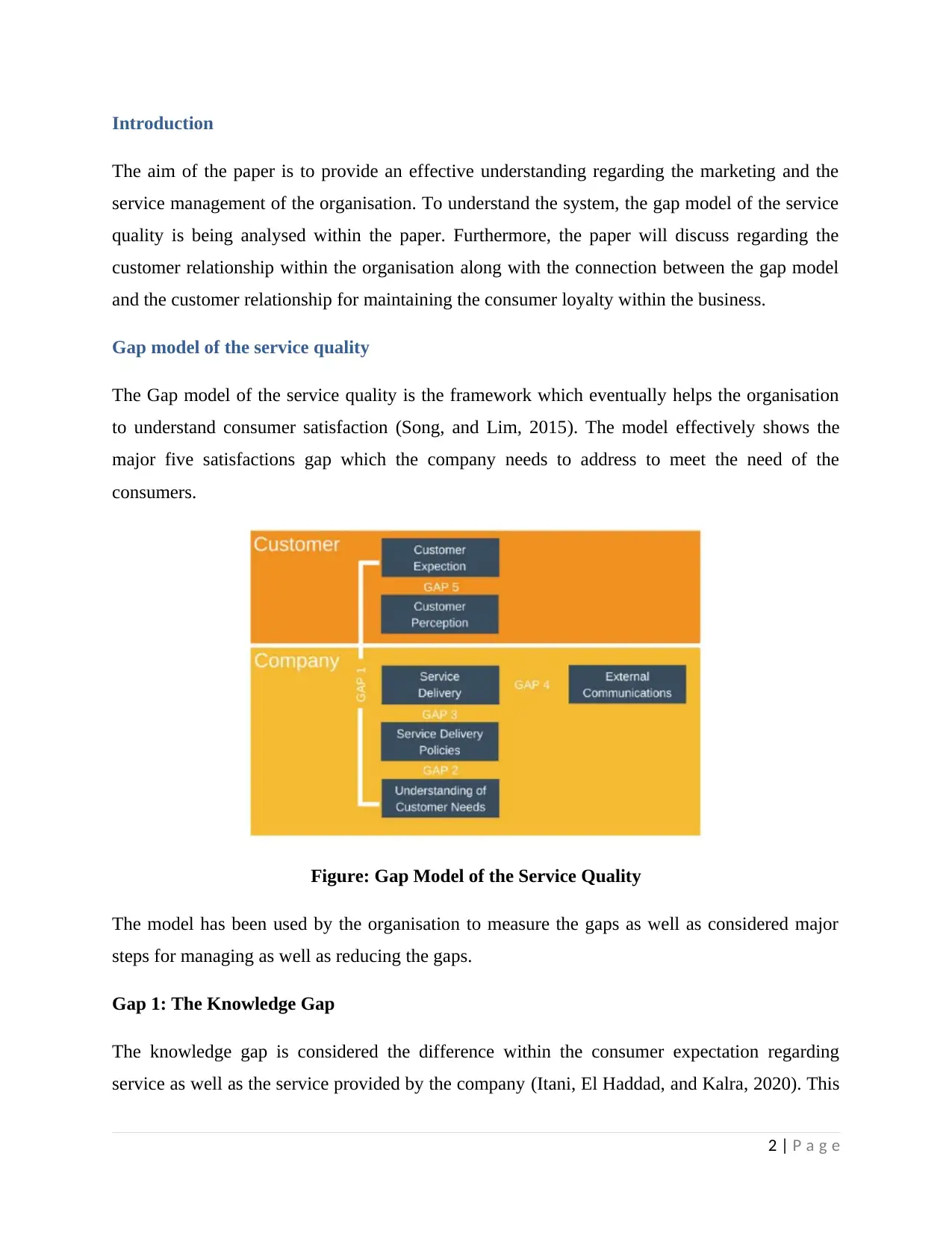
Introduction
The aim of the paper is to provide an effective understanding regarding the marketing and the
service management of the organisation. To understand the system, the gap model of the service
quality is being analysed within the paper. Furthermore, the paper will discuss regarding the
customer relationship within the organisation along with the connection between the gap model
and the customer relationship for maintaining the consumer loyalty within the business.
Gap model of the service quality
The Gap model of the service quality is the framework which eventually helps the organisation
to understand consumer satisfaction (Song, and Lim, 2015). The model effectively shows the
major five satisfactions gap which the company needs to address to meet the need of the
consumers.
Figure: Gap Model of the Service Quality
The model has been used by the organisation to measure the gaps as well as considered major
steps for managing as well as reducing the gaps.
Gap 1: The Knowledge Gap
The knowledge gap is considered the difference within the consumer expectation regarding
service as well as the service provided by the company (Itani, El Haddad, and Kalra, 2020). This
2 | P a g e
The aim of the paper is to provide an effective understanding regarding the marketing and the
service management of the organisation. To understand the system, the gap model of the service
quality is being analysed within the paper. Furthermore, the paper will discuss regarding the
customer relationship within the organisation along with the connection between the gap model
and the customer relationship for maintaining the consumer loyalty within the business.
Gap model of the service quality
The Gap model of the service quality is the framework which eventually helps the organisation
to understand consumer satisfaction (Song, and Lim, 2015). The model effectively shows the
major five satisfactions gap which the company needs to address to meet the need of the
consumers.
Figure: Gap Model of the Service Quality
The model has been used by the organisation to measure the gaps as well as considered major
steps for managing as well as reducing the gaps.
Gap 1: The Knowledge Gap
The knowledge gap is considered the difference within the consumer expectation regarding
service as well as the service provided by the company (Itani, El Haddad, and Kalra, 2020). This
2 | P a g e
⊘ This is a preview!⊘
Do you want full access?
Subscribe today to unlock all pages.

Trusted by 1+ million students worldwide
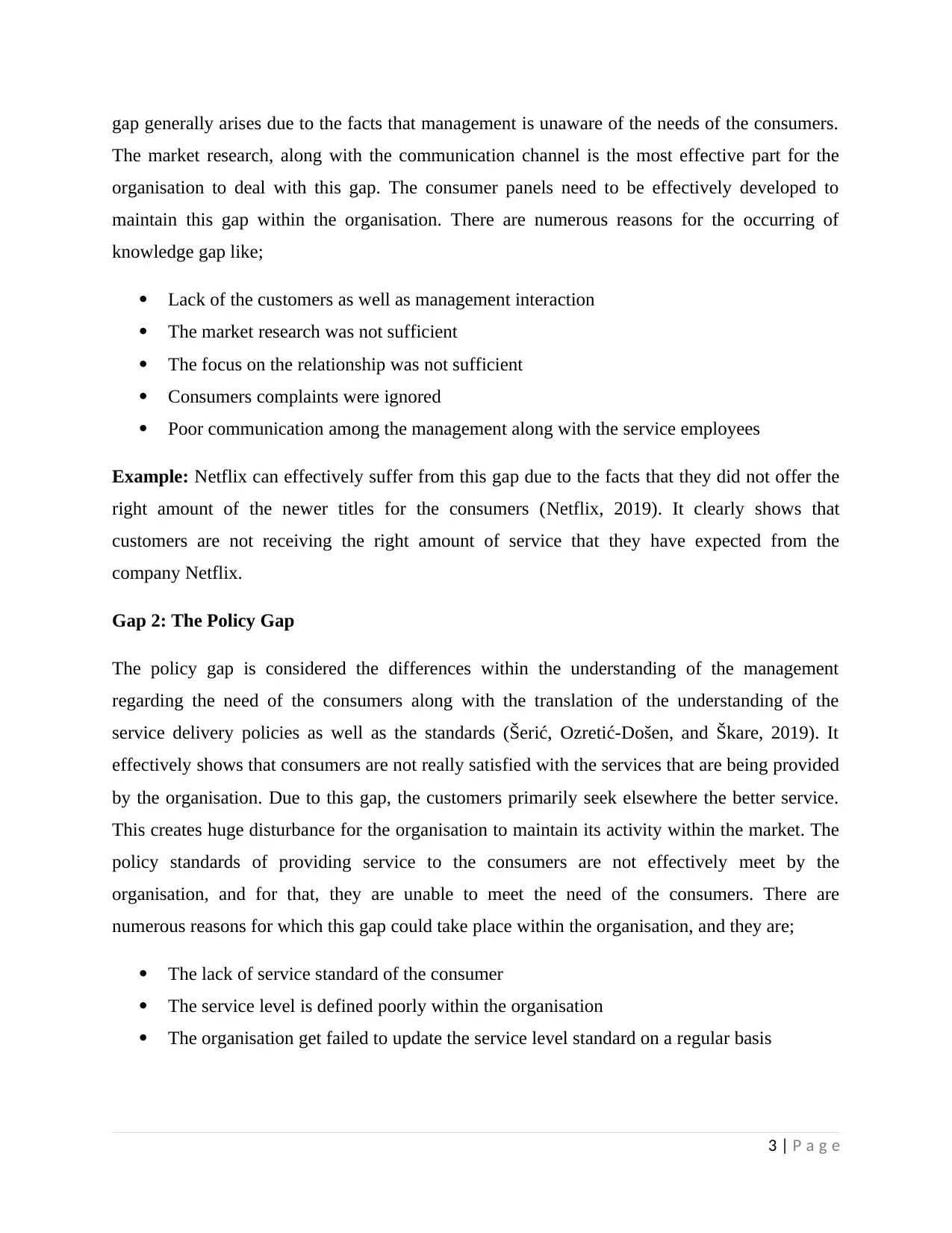
gap generally arises due to the facts that management is unaware of the needs of the consumers.
The market research, along with the communication channel is the most effective part for the
organisation to deal with this gap. The consumer panels need to be effectively developed to
maintain this gap within the organisation. There are numerous reasons for the occurring of
knowledge gap like;
Lack of the customers as well as management interaction
The market research was not sufficient
The focus on the relationship was not sufficient
Consumers complaints were ignored
Poor communication among the management along with the service employees
Example: Netflix can effectively suffer from this gap due to the facts that they did not offer the
right amount of the newer titles for the consumers (Netflix, 2019). It clearly shows that
customers are not receiving the right amount of service that they have expected from the
company Netflix.
Gap 2: The Policy Gap
The policy gap is considered the differences within the understanding of the management
regarding the need of the consumers along with the translation of the understanding of the
service delivery policies as well as the standards (Šerić, Ozretić-Došen, and Škare, 2019). It
effectively shows that consumers are not really satisfied with the services that are being provided
by the organisation. Due to this gap, the customers primarily seek elsewhere the better service.
This creates huge disturbance for the organisation to maintain its activity within the market. The
policy standards of providing service to the consumers are not effectively meet by the
organisation, and for that, they are unable to meet the need of the consumers. There are
numerous reasons for which this gap could take place within the organisation, and they are;
The lack of service standard of the consumer
The service level is defined poorly within the organisation
The organisation get failed to update the service level standard on a regular basis
3 | P a g e
The market research, along with the communication channel is the most effective part for the
organisation to deal with this gap. The consumer panels need to be effectively developed to
maintain this gap within the organisation. There are numerous reasons for the occurring of
knowledge gap like;
Lack of the customers as well as management interaction
The market research was not sufficient
The focus on the relationship was not sufficient
Consumers complaints were ignored
Poor communication among the management along with the service employees
Example: Netflix can effectively suffer from this gap due to the facts that they did not offer the
right amount of the newer titles for the consumers (Netflix, 2019). It clearly shows that
customers are not receiving the right amount of service that they have expected from the
company Netflix.
Gap 2: The Policy Gap
The policy gap is considered the differences within the understanding of the management
regarding the need of the consumers along with the translation of the understanding of the
service delivery policies as well as the standards (Šerić, Ozretić-Došen, and Škare, 2019). It
effectively shows that consumers are not really satisfied with the services that are being provided
by the organisation. Due to this gap, the customers primarily seek elsewhere the better service.
This creates huge disturbance for the organisation to maintain its activity within the market. The
policy standards of providing service to the consumers are not effectively meet by the
organisation, and for that, they are unable to meet the need of the consumers. There are
numerous reasons for which this gap could take place within the organisation, and they are;
The lack of service standard of the consumer
The service level is defined poorly within the organisation
The organisation get failed to update the service level standard on a regular basis
3 | P a g e
Paraphrase This Document
Need a fresh take? Get an instant paraphrase of this document with our AI Paraphraser
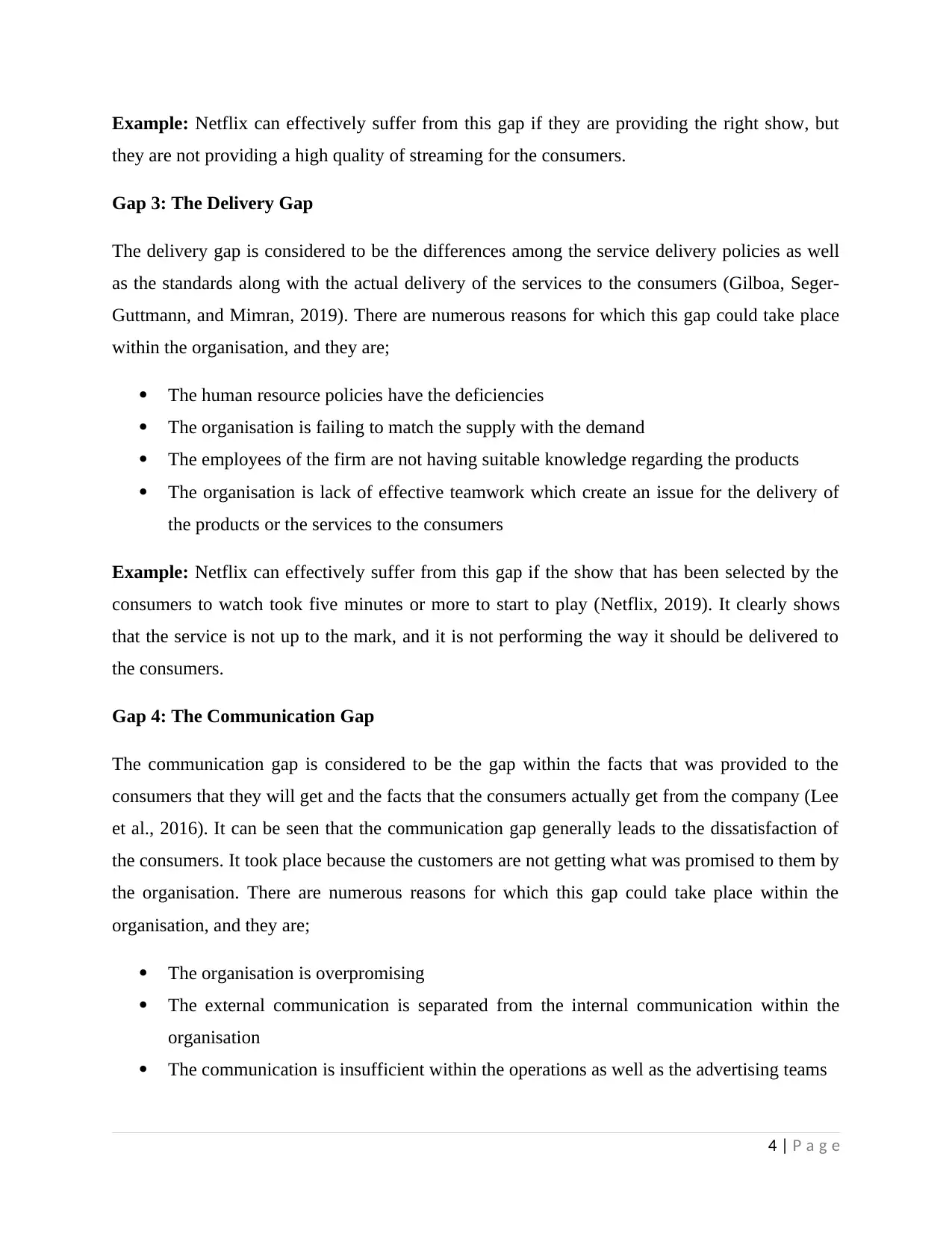
Example: Netflix can effectively suffer from this gap if they are providing the right show, but
they are not providing a high quality of streaming for the consumers.
Gap 3: The Delivery Gap
The delivery gap is considered to be the differences among the service delivery policies as well
as the standards along with the actual delivery of the services to the consumers (Gilboa, Seger-
Guttmann, and Mimran, 2019). There are numerous reasons for which this gap could take place
within the organisation, and they are;
The human resource policies have the deficiencies
The organisation is failing to match the supply with the demand
The employees of the firm are not having suitable knowledge regarding the products
The organisation is lack of effective teamwork which create an issue for the delivery of
the products or the services to the consumers
Example: Netflix can effectively suffer from this gap if the show that has been selected by the
consumers to watch took five minutes or more to start to play (Netflix, 2019). It clearly shows
that the service is not up to the mark, and it is not performing the way it should be delivered to
the consumers.
Gap 4: The Communication Gap
The communication gap is considered to be the gap within the facts that was provided to the
consumers that they will get and the facts that the consumers actually get from the company (Lee
et al., 2016). It can be seen that the communication gap generally leads to the dissatisfaction of
the consumers. It took place because the customers are not getting what was promised to them by
the organisation. There are numerous reasons for which this gap could take place within the
organisation, and they are;
The organisation is overpromising
The external communication is separated from the internal communication within the
organisation
The communication is insufficient within the operations as well as the advertising teams
4 | P a g e
they are not providing a high quality of streaming for the consumers.
Gap 3: The Delivery Gap
The delivery gap is considered to be the differences among the service delivery policies as well
as the standards along with the actual delivery of the services to the consumers (Gilboa, Seger-
Guttmann, and Mimran, 2019). There are numerous reasons for which this gap could take place
within the organisation, and they are;
The human resource policies have the deficiencies
The organisation is failing to match the supply with the demand
The employees of the firm are not having suitable knowledge regarding the products
The organisation is lack of effective teamwork which create an issue for the delivery of
the products or the services to the consumers
Example: Netflix can effectively suffer from this gap if the show that has been selected by the
consumers to watch took five minutes or more to start to play (Netflix, 2019). It clearly shows
that the service is not up to the mark, and it is not performing the way it should be delivered to
the consumers.
Gap 4: The Communication Gap
The communication gap is considered to be the gap within the facts that was provided to the
consumers that they will get and the facts that the consumers actually get from the company (Lee
et al., 2016). It can be seen that the communication gap generally leads to the dissatisfaction of
the consumers. It took place because the customers are not getting what was promised to them by
the organisation. There are numerous reasons for which this gap could take place within the
organisation, and they are;
The organisation is overpromising
The external communication is separated from the internal communication within the
organisation
The communication is insufficient within the operations as well as the advertising teams
4 | P a g e
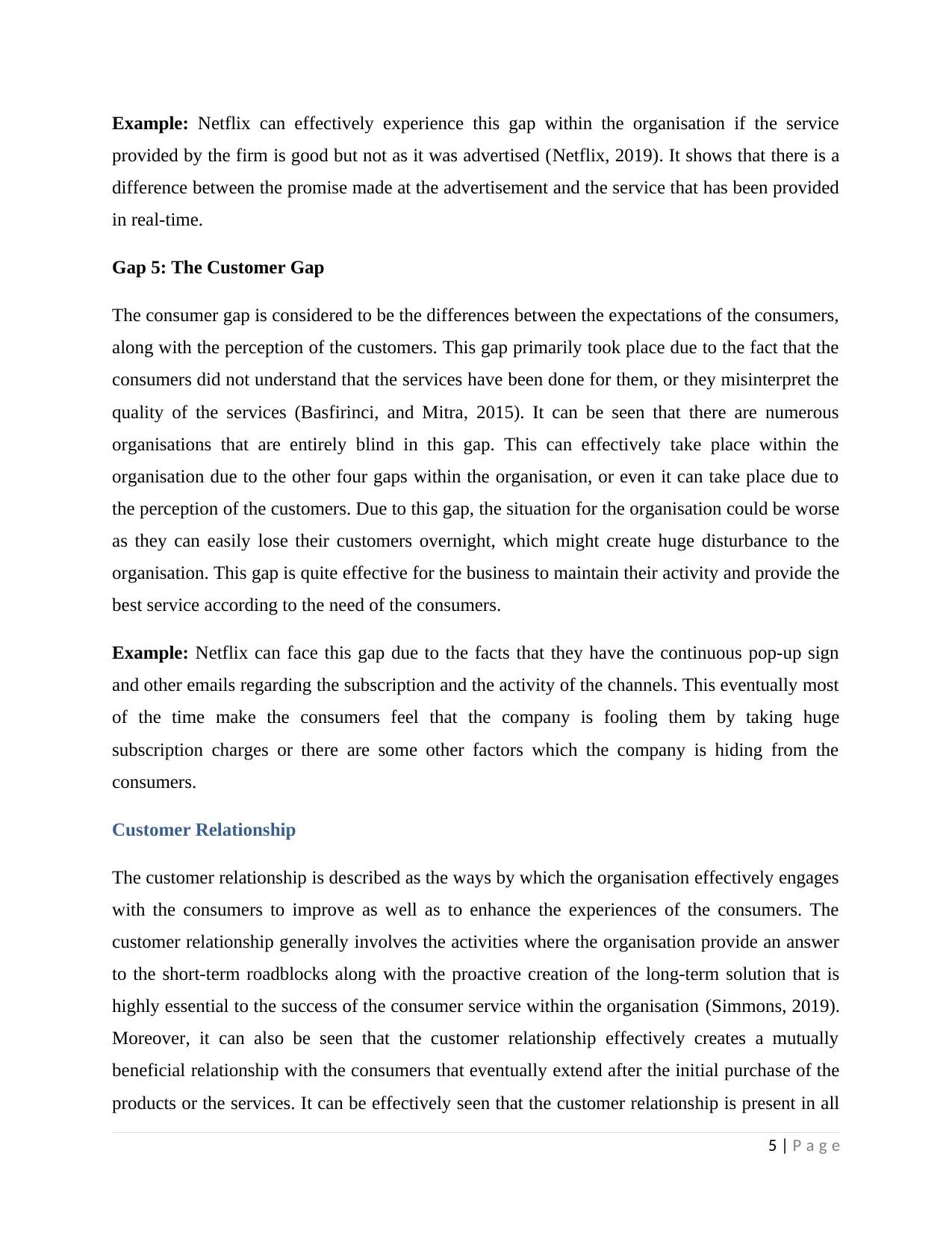
Example: Netflix can effectively experience this gap within the organisation if the service
provided by the firm is good but not as it was advertised (Netflix, 2019). It shows that there is a
difference between the promise made at the advertisement and the service that has been provided
in real-time.
Gap 5: The Customer Gap
The consumer gap is considered to be the differences between the expectations of the consumers,
along with the perception of the customers. This gap primarily took place due to the fact that the
consumers did not understand that the services have been done for them, or they misinterpret the
quality of the services (Basfirinci, and Mitra, 2015). It can be seen that there are numerous
organisations that are entirely blind in this gap. This can effectively take place within the
organisation due to the other four gaps within the organisation, or even it can take place due to
the perception of the customers. Due to this gap, the situation for the organisation could be worse
as they can easily lose their customers overnight, which might create huge disturbance to the
organisation. This gap is quite effective for the business to maintain their activity and provide the
best service according to the need of the consumers.
Example: Netflix can face this gap due to the facts that they have the continuous pop-up sign
and other emails regarding the subscription and the activity of the channels. This eventually most
of the time make the consumers feel that the company is fooling them by taking huge
subscription charges or there are some other factors which the company is hiding from the
consumers.
Customer Relationship
The customer relationship is described as the ways by which the organisation effectively engages
with the consumers to improve as well as to enhance the experiences of the consumers. The
customer relationship generally involves the activities where the organisation provide an answer
to the short-term roadblocks along with the proactive creation of the long-term solution that is
highly essential to the success of the consumer service within the organisation (Simmons, 2019).
Moreover, it can also be seen that the customer relationship effectively creates a mutually
beneficial relationship with the consumers that eventually extend after the initial purchase of the
products or the services. It can be effectively seen that the customer relationship is present in all
5 | P a g e
provided by the firm is good but not as it was advertised (Netflix, 2019). It shows that there is a
difference between the promise made at the advertisement and the service that has been provided
in real-time.
Gap 5: The Customer Gap
The consumer gap is considered to be the differences between the expectations of the consumers,
along with the perception of the customers. This gap primarily took place due to the fact that the
consumers did not understand that the services have been done for them, or they misinterpret the
quality of the services (Basfirinci, and Mitra, 2015). It can be seen that there are numerous
organisations that are entirely blind in this gap. This can effectively take place within the
organisation due to the other four gaps within the organisation, or even it can take place due to
the perception of the customers. Due to this gap, the situation for the organisation could be worse
as they can easily lose their customers overnight, which might create huge disturbance to the
organisation. This gap is quite effective for the business to maintain their activity and provide the
best service according to the need of the consumers.
Example: Netflix can face this gap due to the facts that they have the continuous pop-up sign
and other emails regarding the subscription and the activity of the channels. This eventually most
of the time make the consumers feel that the company is fooling them by taking huge
subscription charges or there are some other factors which the company is hiding from the
consumers.
Customer Relationship
The customer relationship is described as the ways by which the organisation effectively engages
with the consumers to improve as well as to enhance the experiences of the consumers. The
customer relationship generally involves the activities where the organisation provide an answer
to the short-term roadblocks along with the proactive creation of the long-term solution that is
highly essential to the success of the consumer service within the organisation (Simmons, 2019).
Moreover, it can also be seen that the customer relationship effectively creates a mutually
beneficial relationship with the consumers that eventually extend after the initial purchase of the
products or the services. It can be effectively seen that the customer relationship is present in all
5 | P a g e
⊘ This is a preview!⊘
Do you want full access?
Subscribe today to unlock all pages.

Trusted by 1+ million students worldwide
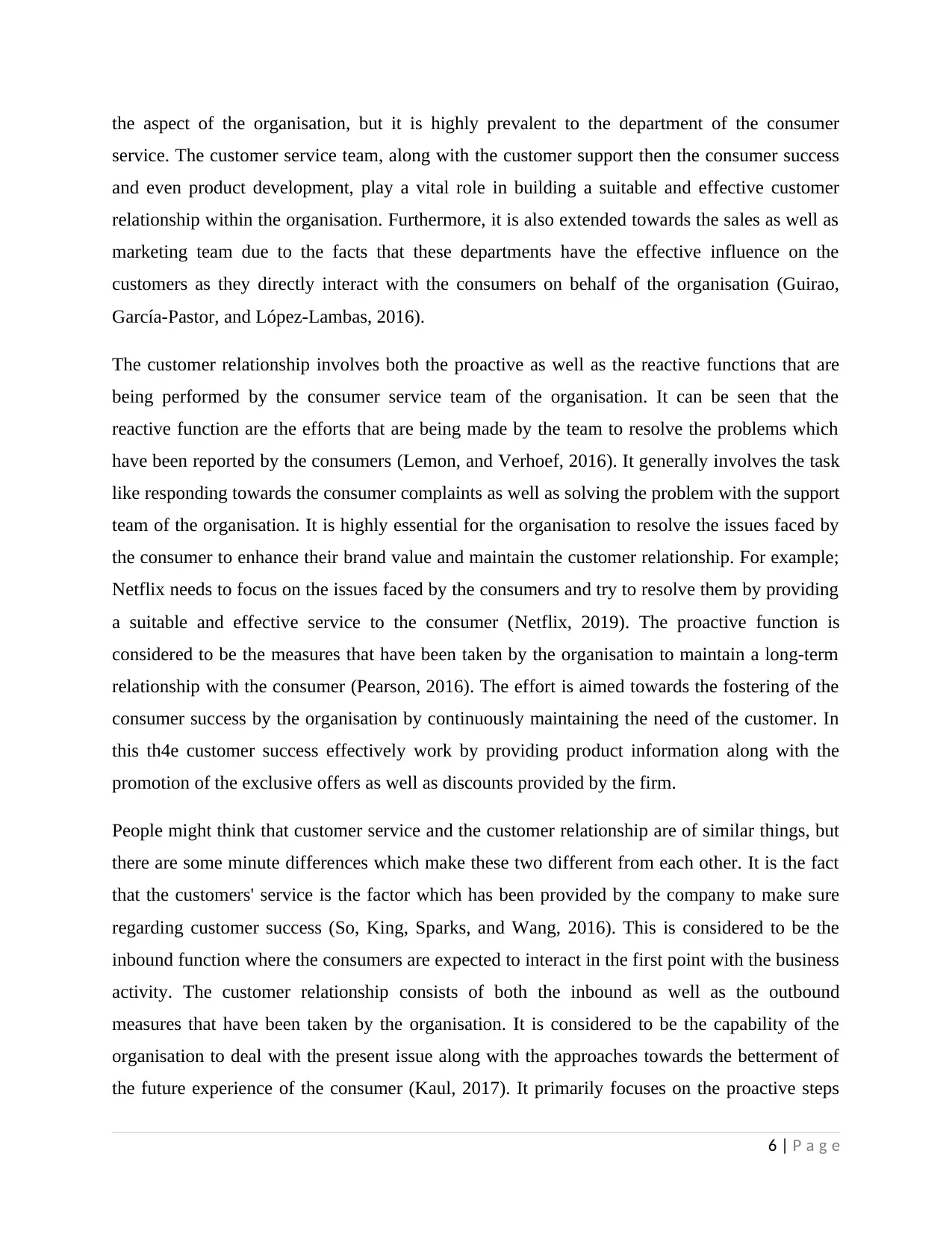
the aspect of the organisation, but it is highly prevalent to the department of the consumer
service. The customer service team, along with the customer support then the consumer success
and even product development, play a vital role in building a suitable and effective customer
relationship within the organisation. Furthermore, it is also extended towards the sales as well as
marketing team due to the facts that these departments have the effective influence on the
customers as they directly interact with the consumers on behalf of the organisation (Guirao,
García-Pastor, and López-Lambas, 2016).
The customer relationship involves both the proactive as well as the reactive functions that are
being performed by the consumer service team of the organisation. It can be seen that the
reactive function are the efforts that are being made by the team to resolve the problems which
have been reported by the consumers (Lemon, and Verhoef, 2016). It generally involves the task
like responding towards the consumer complaints as well as solving the problem with the support
team of the organisation. It is highly essential for the organisation to resolve the issues faced by
the consumer to enhance their brand value and maintain the customer relationship. For example;
Netflix needs to focus on the issues faced by the consumers and try to resolve them by providing
a suitable and effective service to the consumer (Netflix, 2019). The proactive function is
considered to be the measures that have been taken by the organisation to maintain a long-term
relationship with the consumer (Pearson, 2016). The effort is aimed towards the fostering of the
consumer success by the organisation by continuously maintaining the need of the customer. In
this th4e customer success effectively work by providing product information along with the
promotion of the exclusive offers as well as discounts provided by the firm.
People might think that customer service and the customer relationship are of similar things, but
there are some minute differences which make these two different from each other. It is the fact
that the customers' service is the factor which has been provided by the company to make sure
regarding customer success (So, King, Sparks, and Wang, 2016). This is considered to be the
inbound function where the consumers are expected to interact in the first point with the business
activity. The customer relationship consists of both the inbound as well as the outbound
measures that have been taken by the organisation. It is considered to be the capability of the
organisation to deal with the present issue along with the approaches towards the betterment of
the future experience of the consumer (Kaul, 2017). It primarily focuses on the proactive steps
6 | P a g e
service. The customer service team, along with the customer support then the consumer success
and even product development, play a vital role in building a suitable and effective customer
relationship within the organisation. Furthermore, it is also extended towards the sales as well as
marketing team due to the facts that these departments have the effective influence on the
customers as they directly interact with the consumers on behalf of the organisation (Guirao,
García-Pastor, and López-Lambas, 2016).
The customer relationship involves both the proactive as well as the reactive functions that are
being performed by the consumer service team of the organisation. It can be seen that the
reactive function are the efforts that are being made by the team to resolve the problems which
have been reported by the consumers (Lemon, and Verhoef, 2016). It generally involves the task
like responding towards the consumer complaints as well as solving the problem with the support
team of the organisation. It is highly essential for the organisation to resolve the issues faced by
the consumer to enhance their brand value and maintain the customer relationship. For example;
Netflix needs to focus on the issues faced by the consumers and try to resolve them by providing
a suitable and effective service to the consumer (Netflix, 2019). The proactive function is
considered to be the measures that have been taken by the organisation to maintain a long-term
relationship with the consumer (Pearson, 2016). The effort is aimed towards the fostering of the
consumer success by the organisation by continuously maintaining the need of the customer. In
this th4e customer success effectively work by providing product information along with the
promotion of the exclusive offers as well as discounts provided by the firm.
People might think that customer service and the customer relationship are of similar things, but
there are some minute differences which make these two different from each other. It is the fact
that the customers' service is the factor which has been provided by the company to make sure
regarding customer success (So, King, Sparks, and Wang, 2016). This is considered to be the
inbound function where the consumers are expected to interact in the first point with the business
activity. The customer relationship consists of both the inbound as well as the outbound
measures that have been taken by the organisation. It is considered to be the capability of the
organisation to deal with the present issue along with the approaches towards the betterment of
the future experience of the consumer (Kaul, 2017). It primarily focuses on the proactive steps
6 | P a g e
Paraphrase This Document
Need a fresh take? Get an instant paraphrase of this document with our AI Paraphraser
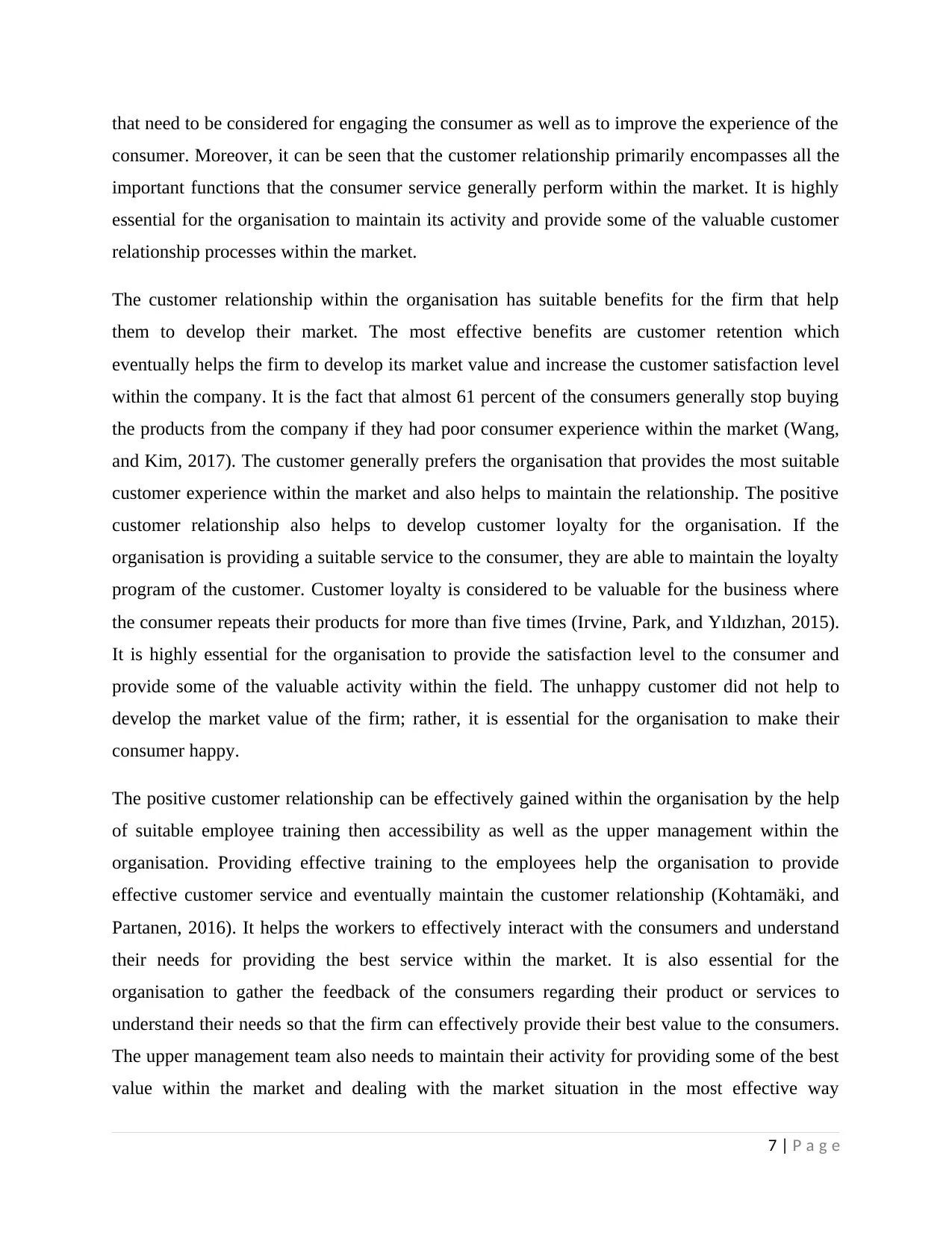
that need to be considered for engaging the consumer as well as to improve the experience of the
consumer. Moreover, it can be seen that the customer relationship primarily encompasses all the
important functions that the consumer service generally perform within the market. It is highly
essential for the organisation to maintain its activity and provide some of the valuable customer
relationship processes within the market.
The customer relationship within the organisation has suitable benefits for the firm that help
them to develop their market. The most effective benefits are customer retention which
eventually helps the firm to develop its market value and increase the customer satisfaction level
within the company. It is the fact that almost 61 percent of the consumers generally stop buying
the products from the company if they had poor consumer experience within the market (Wang,
and Kim, 2017). The customer generally prefers the organisation that provides the most suitable
customer experience within the market and also helps to maintain the relationship. The positive
customer relationship also helps to develop customer loyalty for the organisation. If the
organisation is providing a suitable service to the consumer, they are able to maintain the loyalty
program of the customer. Customer loyalty is considered to be valuable for the business where
the consumer repeats their products for more than five times (Irvine, Park, and Yıldızhan, 2015).
It is highly essential for the organisation to provide the satisfaction level to the consumer and
provide some of the valuable activity within the field. The unhappy customer did not help to
develop the market value of the firm; rather, it is essential for the organisation to make their
consumer happy.
The positive customer relationship can be effectively gained within the organisation by the help
of suitable employee training then accessibility as well as the upper management within the
organisation. Providing effective training to the employees help the organisation to provide
effective customer service and eventually maintain the customer relationship (Kohtamäki, and
Partanen, 2016). It helps the workers to effectively interact with the consumers and understand
their needs for providing the best service within the market. It is also essential for the
organisation to gather the feedback of the consumers regarding their product or services to
understand their needs so that the firm can effectively provide their best value to the consumers.
The upper management team also needs to maintain their activity for providing some of the best
value within the market and dealing with the market situation in the most effective way
7 | P a g e
consumer. Moreover, it can be seen that the customer relationship primarily encompasses all the
important functions that the consumer service generally perform within the market. It is highly
essential for the organisation to maintain its activity and provide some of the valuable customer
relationship processes within the market.
The customer relationship within the organisation has suitable benefits for the firm that help
them to develop their market. The most effective benefits are customer retention which
eventually helps the firm to develop its market value and increase the customer satisfaction level
within the company. It is the fact that almost 61 percent of the consumers generally stop buying
the products from the company if they had poor consumer experience within the market (Wang,
and Kim, 2017). The customer generally prefers the organisation that provides the most suitable
customer experience within the market and also helps to maintain the relationship. The positive
customer relationship also helps to develop customer loyalty for the organisation. If the
organisation is providing a suitable service to the consumer, they are able to maintain the loyalty
program of the customer. Customer loyalty is considered to be valuable for the business where
the consumer repeats their products for more than five times (Irvine, Park, and Yıldızhan, 2015).
It is highly essential for the organisation to provide the satisfaction level to the consumer and
provide some of the valuable activity within the field. The unhappy customer did not help to
develop the market value of the firm; rather, it is essential for the organisation to make their
consumer happy.
The positive customer relationship can be effectively gained within the organisation by the help
of suitable employee training then accessibility as well as the upper management within the
organisation. Providing effective training to the employees help the organisation to provide
effective customer service and eventually maintain the customer relationship (Kohtamäki, and
Partanen, 2016). It helps the workers to effectively interact with the consumers and understand
their needs for providing the best service within the market. It is also essential for the
organisation to gather the feedback of the consumers regarding their product or services to
understand their needs so that the firm can effectively provide their best value to the consumers.
The upper management team also needs to maintain their activity for providing some of the best
value within the market and dealing with the market situation in the most effective way
7 | P a g e
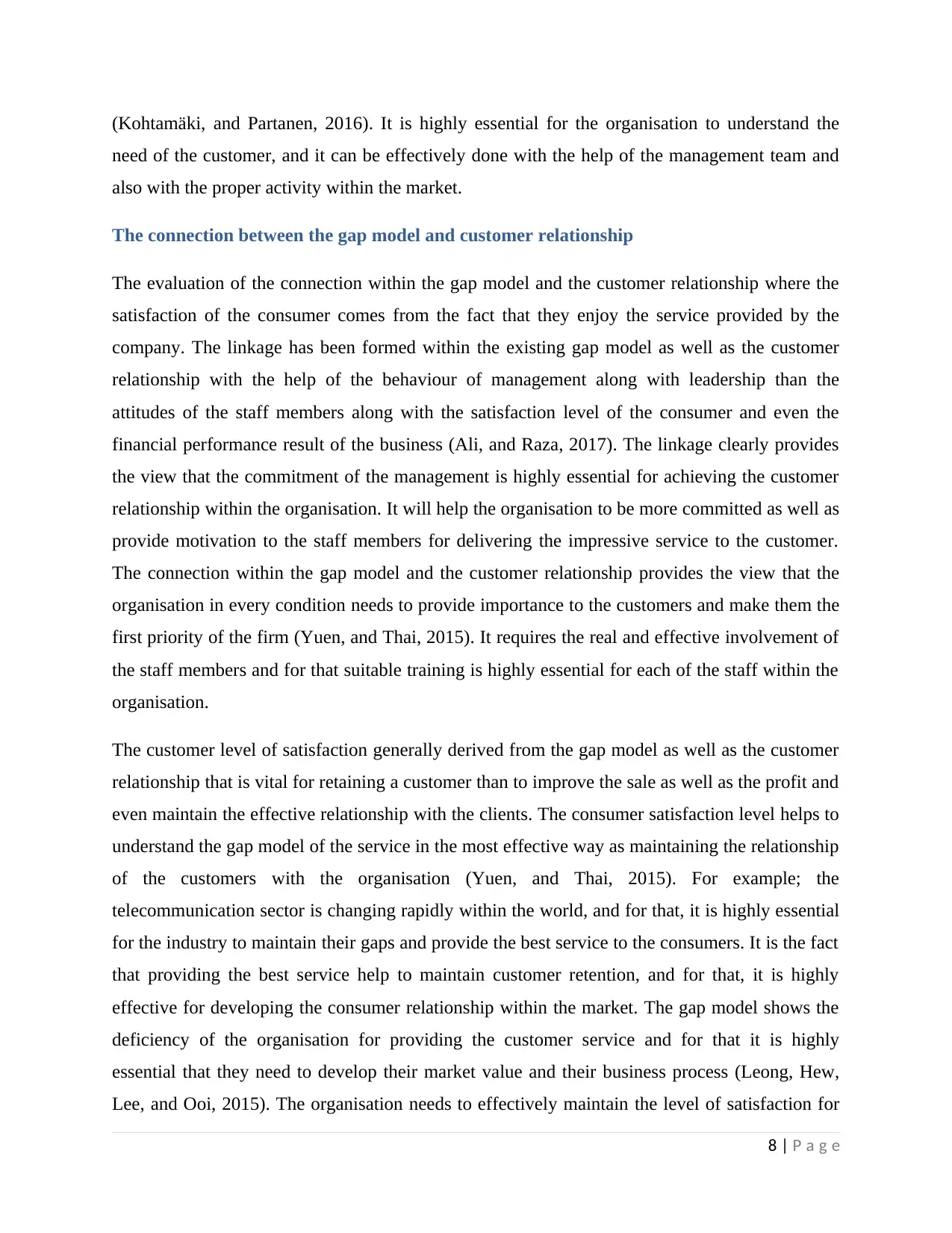
(Kohtamäki, and Partanen, 2016). It is highly essential for the organisation to understand the
need of the customer, and it can be effectively done with the help of the management team and
also with the proper activity within the market.
The connection between the gap model and customer relationship
The evaluation of the connection within the gap model and the customer relationship where the
satisfaction of the consumer comes from the fact that they enjoy the service provided by the
company. The linkage has been formed within the existing gap model as well as the customer
relationship with the help of the behaviour of management along with leadership than the
attitudes of the staff members along with the satisfaction level of the consumer and even the
financial performance result of the business (Ali, and Raza, 2017). The linkage clearly provides
the view that the commitment of the management is highly essential for achieving the customer
relationship within the organisation. It will help the organisation to be more committed as well as
provide motivation to the staff members for delivering the impressive service to the customer.
The connection within the gap model and the customer relationship provides the view that the
organisation in every condition needs to provide importance to the customers and make them the
first priority of the firm (Yuen, and Thai, 2015). It requires the real and effective involvement of
the staff members and for that suitable training is highly essential for each of the staff within the
organisation.
The customer level of satisfaction generally derived from the gap model as well as the customer
relationship that is vital for retaining a customer than to improve the sale as well as the profit and
even maintain the effective relationship with the clients. The consumer satisfaction level helps to
understand the gap model of the service in the most effective way as maintaining the relationship
of the customers with the organisation (Yuen, and Thai, 2015). For example; the
telecommunication sector is changing rapidly within the world, and for that, it is highly essential
for the industry to maintain their gaps and provide the best service to the consumers. It is the fact
that providing the best service help to maintain customer retention, and for that, it is highly
effective for developing the consumer relationship within the market. The gap model shows the
deficiency of the organisation for providing the customer service and for that it is highly
essential that they need to develop their market value and their business process (Leong, Hew,
Lee, and Ooi, 2015). The organisation needs to effectively maintain the level of satisfaction for
8 | P a g e
need of the customer, and it can be effectively done with the help of the management team and
also with the proper activity within the market.
The connection between the gap model and customer relationship
The evaluation of the connection within the gap model and the customer relationship where the
satisfaction of the consumer comes from the fact that they enjoy the service provided by the
company. The linkage has been formed within the existing gap model as well as the customer
relationship with the help of the behaviour of management along with leadership than the
attitudes of the staff members along with the satisfaction level of the consumer and even the
financial performance result of the business (Ali, and Raza, 2017). The linkage clearly provides
the view that the commitment of the management is highly essential for achieving the customer
relationship within the organisation. It will help the organisation to be more committed as well as
provide motivation to the staff members for delivering the impressive service to the customer.
The connection within the gap model and the customer relationship provides the view that the
organisation in every condition needs to provide importance to the customers and make them the
first priority of the firm (Yuen, and Thai, 2015). It requires the real and effective involvement of
the staff members and for that suitable training is highly essential for each of the staff within the
organisation.
The customer level of satisfaction generally derived from the gap model as well as the customer
relationship that is vital for retaining a customer than to improve the sale as well as the profit and
even maintain the effective relationship with the clients. The consumer satisfaction level helps to
understand the gap model of the service in the most effective way as maintaining the relationship
of the customers with the organisation (Yuen, and Thai, 2015). For example; the
telecommunication sector is changing rapidly within the world, and for that, it is highly essential
for the industry to maintain their gaps and provide the best service to the consumers. It is the fact
that providing the best service help to maintain customer retention, and for that, it is highly
effective for developing the consumer relationship within the market. The gap model shows the
deficiency of the organisation for providing the customer service and for that it is highly
essential that they need to develop their market value and their business process (Leong, Hew,
Lee, and Ooi, 2015). The organisation needs to effectively maintain the level of satisfaction for
8 | P a g e
⊘ This is a preview!⊘
Do you want full access?
Subscribe today to unlock all pages.

Trusted by 1+ million students worldwide
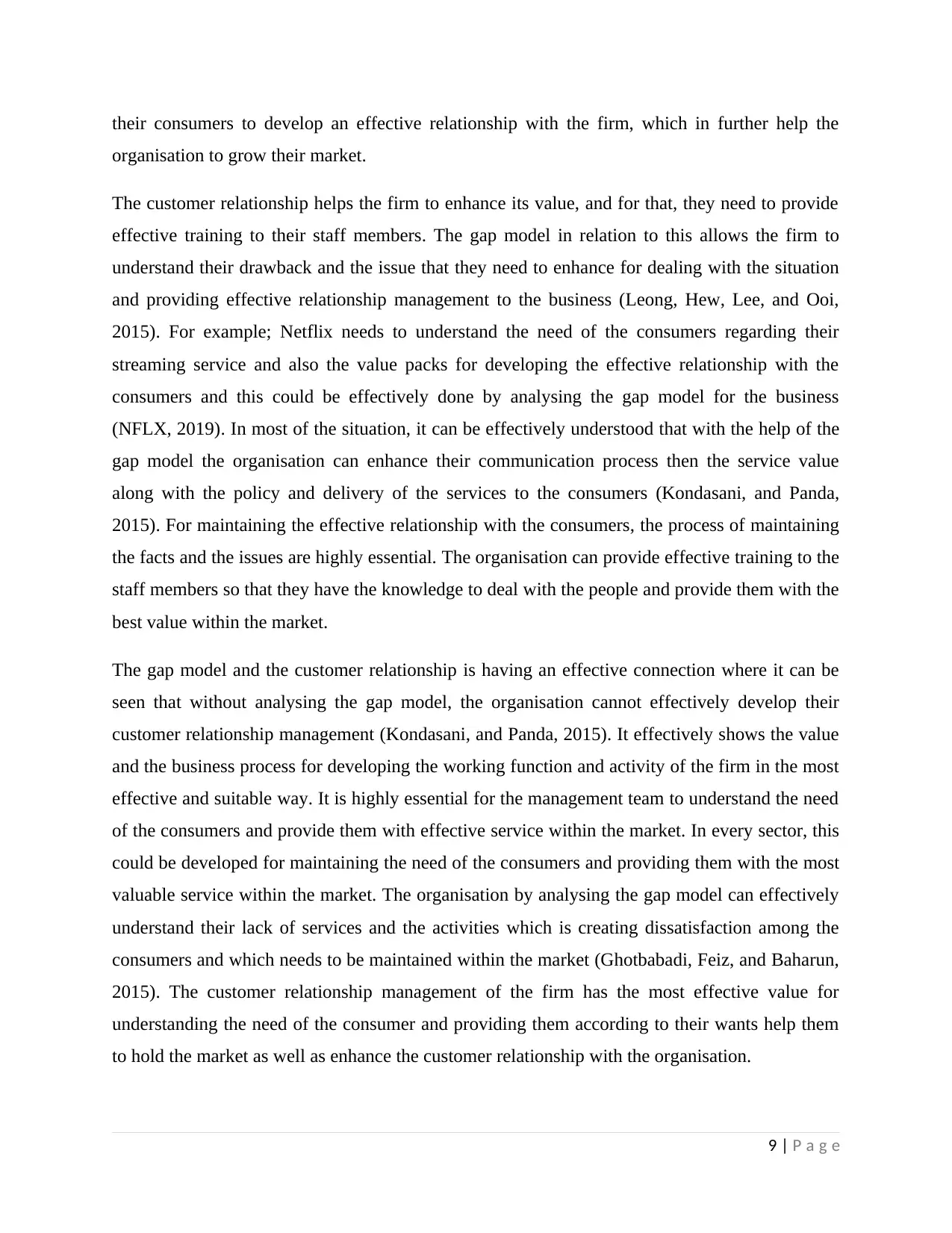
their consumers to develop an effective relationship with the firm, which in further help the
organisation to grow their market.
The customer relationship helps the firm to enhance its value, and for that, they need to provide
effective training to their staff members. The gap model in relation to this allows the firm to
understand their drawback and the issue that they need to enhance for dealing with the situation
and providing effective relationship management to the business (Leong, Hew, Lee, and Ooi,
2015). For example; Netflix needs to understand the need of the consumers regarding their
streaming service and also the value packs for developing the effective relationship with the
consumers and this could be effectively done by analysing the gap model for the business
(NFLX, 2019). In most of the situation, it can be effectively understood that with the help of the
gap model the organisation can enhance their communication process then the service value
along with the policy and delivery of the services to the consumers (Kondasani, and Panda,
2015). For maintaining the effective relationship with the consumers, the process of maintaining
the facts and the issues are highly essential. The organisation can provide effective training to the
staff members so that they have the knowledge to deal with the people and provide them with the
best value within the market.
The gap model and the customer relationship is having an effective connection where it can be
seen that without analysing the gap model, the organisation cannot effectively develop their
customer relationship management (Kondasani, and Panda, 2015). It effectively shows the value
and the business process for developing the working function and activity of the firm in the most
effective and suitable way. It is highly essential for the management team to understand the need
of the consumers and provide them with effective service within the market. In every sector, this
could be developed for maintaining the need of the consumers and providing them with the most
valuable service within the market. The organisation by analysing the gap model can effectively
understand their lack of services and the activities which is creating dissatisfaction among the
consumers and which needs to be maintained within the market (Ghotbabadi, Feiz, and Baharun,
2015). The customer relationship management of the firm has the most effective value for
understanding the need of the consumer and providing them according to their wants help them
to hold the market as well as enhance the customer relationship with the organisation.
9 | P a g e
organisation to grow their market.
The customer relationship helps the firm to enhance its value, and for that, they need to provide
effective training to their staff members. The gap model in relation to this allows the firm to
understand their drawback and the issue that they need to enhance for dealing with the situation
and providing effective relationship management to the business (Leong, Hew, Lee, and Ooi,
2015). For example; Netflix needs to understand the need of the consumers regarding their
streaming service and also the value packs for developing the effective relationship with the
consumers and this could be effectively done by analysing the gap model for the business
(NFLX, 2019). In most of the situation, it can be effectively understood that with the help of the
gap model the organisation can enhance their communication process then the service value
along with the policy and delivery of the services to the consumers (Kondasani, and Panda,
2015). For maintaining the effective relationship with the consumers, the process of maintaining
the facts and the issues are highly essential. The organisation can provide effective training to the
staff members so that they have the knowledge to deal with the people and provide them with the
best value within the market.
The gap model and the customer relationship is having an effective connection where it can be
seen that without analysing the gap model, the organisation cannot effectively develop their
customer relationship management (Kondasani, and Panda, 2015). It effectively shows the value
and the business process for developing the working function and activity of the firm in the most
effective and suitable way. It is highly essential for the management team to understand the need
of the consumers and provide them with effective service within the market. In every sector, this
could be developed for maintaining the need of the consumers and providing them with the most
valuable service within the market. The organisation by analysing the gap model can effectively
understand their lack of services and the activities which is creating dissatisfaction among the
consumers and which needs to be maintained within the market (Ghotbabadi, Feiz, and Baharun,
2015). The customer relationship management of the firm has the most effective value for
understanding the need of the consumer and providing them according to their wants help them
to hold the market as well as enhance the customer relationship with the organisation.
9 | P a g e
Paraphrase This Document
Need a fresh take? Get an instant paraphrase of this document with our AI Paraphraser
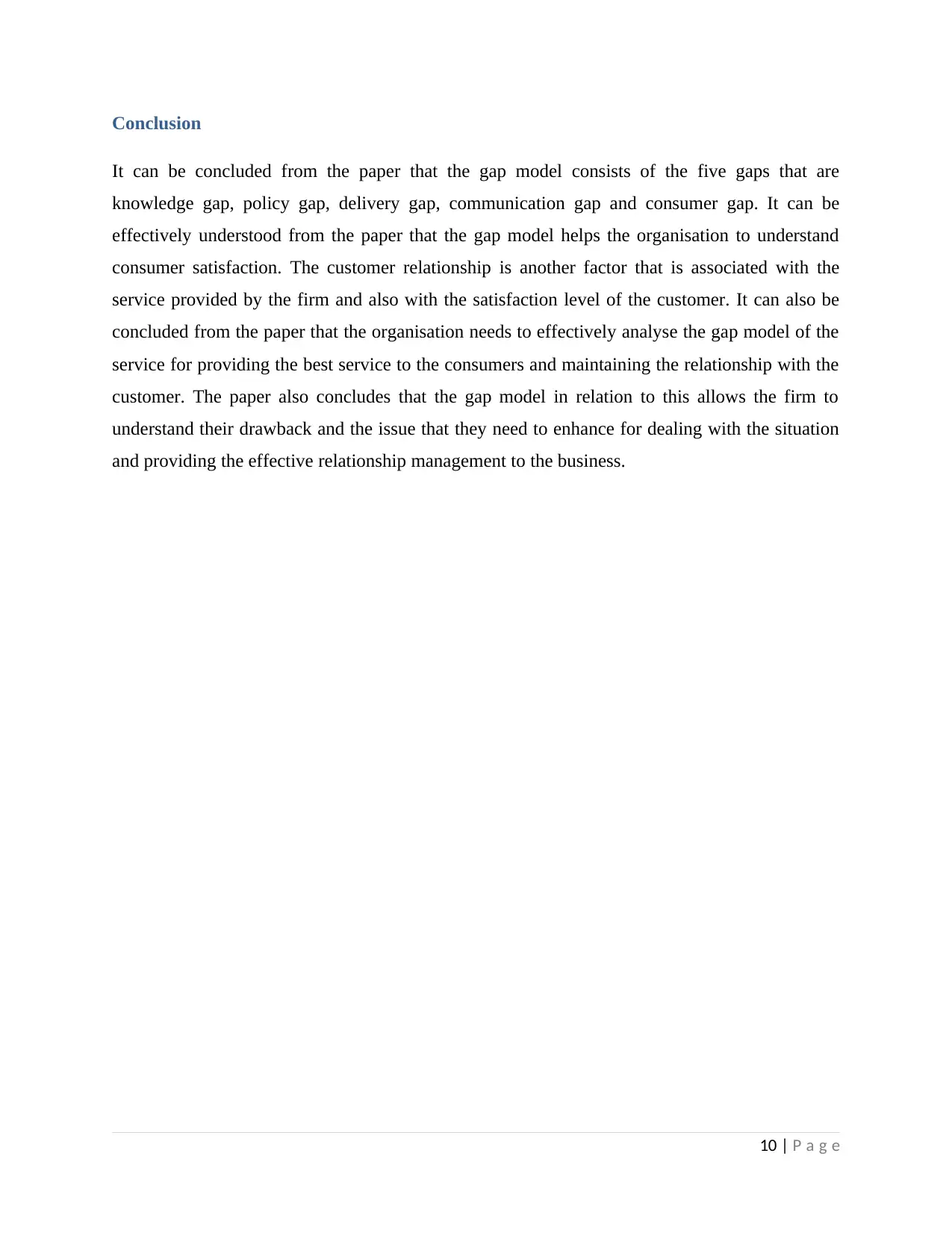
Conclusion
It can be concluded from the paper that the gap model consists of the five gaps that are
knowledge gap, policy gap, delivery gap, communication gap and consumer gap. It can be
effectively understood from the paper that the gap model helps the organisation to understand
consumer satisfaction. The customer relationship is another factor that is associated with the
service provided by the firm and also with the satisfaction level of the customer. It can also be
concluded from the paper that the organisation needs to effectively analyse the gap model of the
service for providing the best service to the consumers and maintaining the relationship with the
customer. The paper also concludes that the gap model in relation to this allows the firm to
understand their drawback and the issue that they need to enhance for dealing with the situation
and providing the effective relationship management to the business.
10 | P a g e
It can be concluded from the paper that the gap model consists of the five gaps that are
knowledge gap, policy gap, delivery gap, communication gap and consumer gap. It can be
effectively understood from the paper that the gap model helps the organisation to understand
consumer satisfaction. The customer relationship is another factor that is associated with the
service provided by the firm and also with the satisfaction level of the customer. It can also be
concluded from the paper that the organisation needs to effectively analyse the gap model of the
service for providing the best service to the consumers and maintaining the relationship with the
customer. The paper also concludes that the gap model in relation to this allows the firm to
understand their drawback and the issue that they need to enhance for dealing with the situation
and providing the effective relationship management to the business.
10 | P a g e
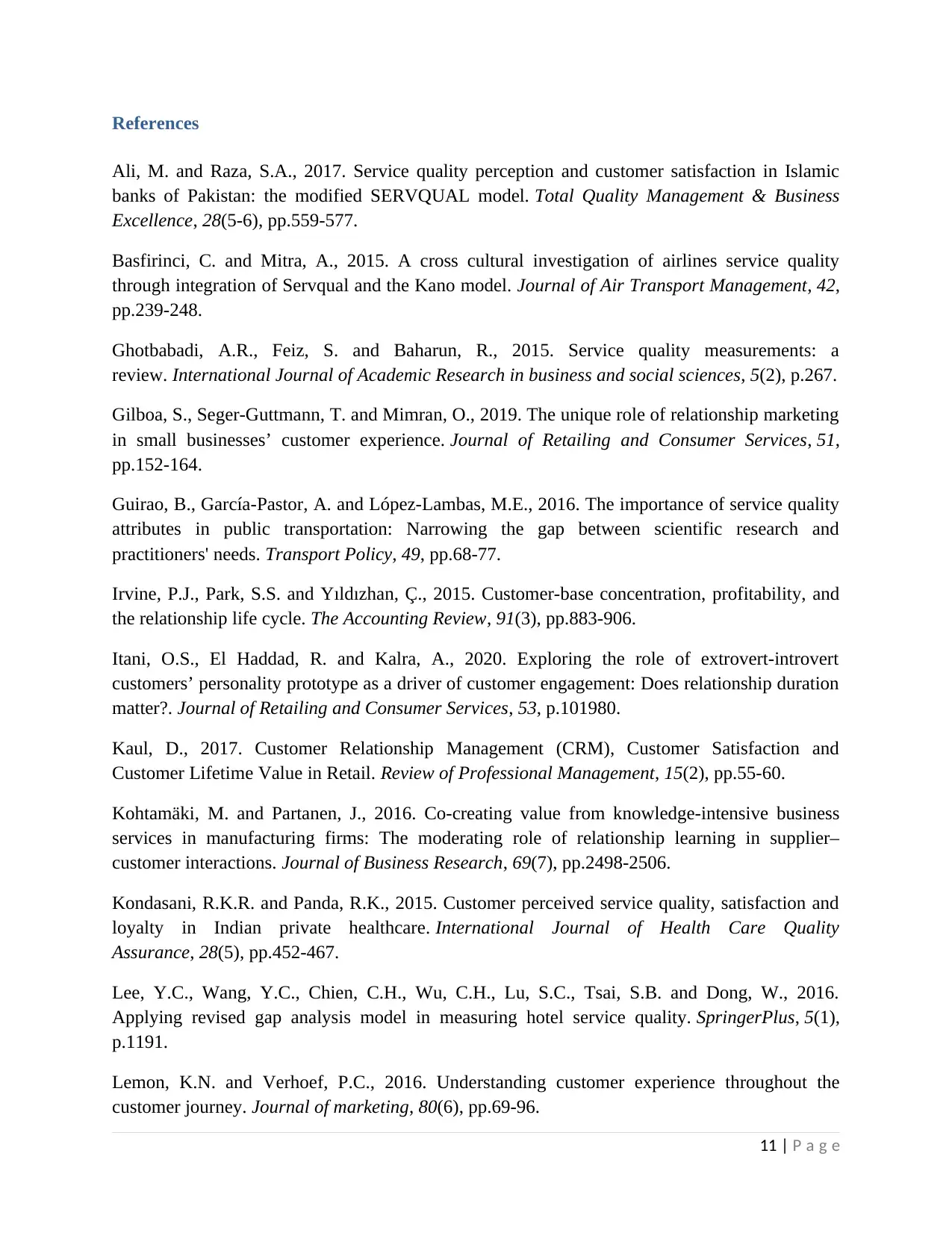
References
Ali, M. and Raza, S.A., 2017. Service quality perception and customer satisfaction in Islamic
banks of Pakistan: the modified SERVQUAL model. Total Quality Management & Business
Excellence, 28(5-6), pp.559-577.
Basfirinci, C. and Mitra, A., 2015. A cross cultural investigation of airlines service quality
through integration of Servqual and the Kano model. Journal of Air Transport Management, 42,
pp.239-248.
Ghotbabadi, A.R., Feiz, S. and Baharun, R., 2015. Service quality measurements: a
review. International Journal of Academic Research in business and social sciences, 5(2), p.267.
Gilboa, S., Seger-Guttmann, T. and Mimran, O., 2019. The unique role of relationship marketing
in small businesses’ customer experience. Journal of Retailing and Consumer Services, 51,
pp.152-164.
Guirao, B., García-Pastor, A. and López-Lambas, M.E., 2016. The importance of service quality
attributes in public transportation: Narrowing the gap between scientific research and
practitioners' needs. Transport Policy, 49, pp.68-77.
Irvine, P.J., Park, S.S. and Yıldızhan, Ç., 2015. Customer-base concentration, profitability, and
the relationship life cycle. The Accounting Review, 91(3), pp.883-906.
Itani, O.S., El Haddad, R. and Kalra, A., 2020. Exploring the role of extrovert-introvert
customers’ personality prototype as a driver of customer engagement: Does relationship duration
matter?. Journal of Retailing and Consumer Services, 53, p.101980.
Kaul, D., 2017. Customer Relationship Management (CRM), Customer Satisfaction and
Customer Lifetime Value in Retail. Review of Professional Management, 15(2), pp.55-60.
Kohtamäki, M. and Partanen, J., 2016. Co-creating value from knowledge-intensive business
services in manufacturing firms: The moderating role of relationship learning in supplier–
customer interactions. Journal of Business Research, 69(7), pp.2498-2506.
Kondasani, R.K.R. and Panda, R.K., 2015. Customer perceived service quality, satisfaction and
loyalty in Indian private healthcare. International Journal of Health Care Quality
Assurance, 28(5), pp.452-467.
Lee, Y.C., Wang, Y.C., Chien, C.H., Wu, C.H., Lu, S.C., Tsai, S.B. and Dong, W., 2016.
Applying revised gap analysis model in measuring hotel service quality. SpringerPlus, 5(1),
p.1191.
Lemon, K.N. and Verhoef, P.C., 2016. Understanding customer experience throughout the
customer journey. Journal of marketing, 80(6), pp.69-96.
11 | P a g e
Ali, M. and Raza, S.A., 2017. Service quality perception and customer satisfaction in Islamic
banks of Pakistan: the modified SERVQUAL model. Total Quality Management & Business
Excellence, 28(5-6), pp.559-577.
Basfirinci, C. and Mitra, A., 2015. A cross cultural investigation of airlines service quality
through integration of Servqual and the Kano model. Journal of Air Transport Management, 42,
pp.239-248.
Ghotbabadi, A.R., Feiz, S. and Baharun, R., 2015. Service quality measurements: a
review. International Journal of Academic Research in business and social sciences, 5(2), p.267.
Gilboa, S., Seger-Guttmann, T. and Mimran, O., 2019. The unique role of relationship marketing
in small businesses’ customer experience. Journal of Retailing and Consumer Services, 51,
pp.152-164.
Guirao, B., García-Pastor, A. and López-Lambas, M.E., 2016. The importance of service quality
attributes in public transportation: Narrowing the gap between scientific research and
practitioners' needs. Transport Policy, 49, pp.68-77.
Irvine, P.J., Park, S.S. and Yıldızhan, Ç., 2015. Customer-base concentration, profitability, and
the relationship life cycle. The Accounting Review, 91(3), pp.883-906.
Itani, O.S., El Haddad, R. and Kalra, A., 2020. Exploring the role of extrovert-introvert
customers’ personality prototype as a driver of customer engagement: Does relationship duration
matter?. Journal of Retailing and Consumer Services, 53, p.101980.
Kaul, D., 2017. Customer Relationship Management (CRM), Customer Satisfaction and
Customer Lifetime Value in Retail. Review of Professional Management, 15(2), pp.55-60.
Kohtamäki, M. and Partanen, J., 2016. Co-creating value from knowledge-intensive business
services in manufacturing firms: The moderating role of relationship learning in supplier–
customer interactions. Journal of Business Research, 69(7), pp.2498-2506.
Kondasani, R.K.R. and Panda, R.K., 2015. Customer perceived service quality, satisfaction and
loyalty in Indian private healthcare. International Journal of Health Care Quality
Assurance, 28(5), pp.452-467.
Lee, Y.C., Wang, Y.C., Chien, C.H., Wu, C.H., Lu, S.C., Tsai, S.B. and Dong, W., 2016.
Applying revised gap analysis model in measuring hotel service quality. SpringerPlus, 5(1),
p.1191.
Lemon, K.N. and Verhoef, P.C., 2016. Understanding customer experience throughout the
customer journey. Journal of marketing, 80(6), pp.69-96.
11 | P a g e
⊘ This is a preview!⊘
Do you want full access?
Subscribe today to unlock all pages.

Trusted by 1+ million students worldwide
1 out of 13
Related Documents
Your All-in-One AI-Powered Toolkit for Academic Success.
+13062052269
info@desklib.com
Available 24*7 on WhatsApp / Email
![[object Object]](/_next/static/media/star-bottom.7253800d.svg)
Unlock your academic potential
Copyright © 2020–2025 A2Z Services. All Rights Reserved. Developed and managed by ZUCOL.





